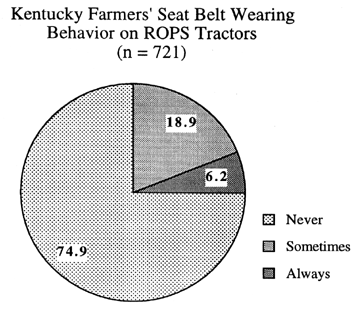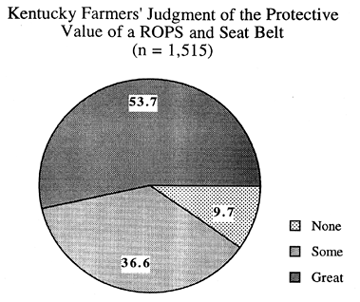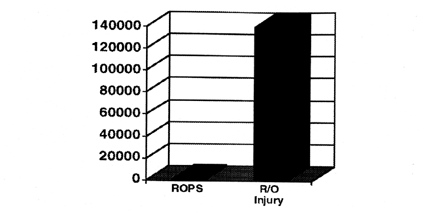Instructor's Guide and Activity Materials Table of Contents
Follow-up Notes, Questions, and Activities
Use these questions and notes when the participants have completed the Mr. Good Egg activity. The questions, notes, and illustrations provide additional information related to the activity. The instructor can also have handy and use many other graphs, tables, materials, and activities developed by the CPHF ROPS project and the TRAC-SAFE project. Having additional resources available is an effective way to provide information to participants at teachable moments "teachable" moments when they raise questions.
More follow-up activities than can be used in one session are included here. If an instructor has an opportunity to conduct a series of sessions with a group of participants, a program of activities can be developed around the Mr. Good Egg activity or other CPHF KY ROPS Project and TRAC-SAFE materials and activities. It is more effective to conduct a series of related shorter activities and presentations with a group of participants over several meetings than it is to try to cram too much into one longer session. It is also very important to allow time for the participants to interact, talk to one another, and collaborate as the activities are completed.
Discussion
Questions
Are
real farmers hurt and killed in overturns of real tractors?
Nearly 400 farmers die in tractor overturns in the United States Each year. In I994-95 in Kentucky, 41 farmers died in tractor overturns. All would have lived if they had been on ROPS-equipped tractor and had been wearing a seat belt. (See the "A Tough Quiz"figure.)
A ROPS and seat belt can't keep a person from tipping a tractor over, but they do protect a person from being hurt or killed. ROPS and seat belts used together are 99% effective in preventing injuries and fatalities during tractor overturns. Why do you thinks this is? What does it mean to say that a ROPS and a fastened seat belt is 99% effective? (It means that out of every 100 people who overturn a ROPS-equipped tractor, and who are wearing the seat belt, that only one of these persons is hurt.)
This is a good time to show the three overhead transparencies titled, "100 Kentucky Mr . Good Egg Farmers on their Tractors. "These drawings show 100 farmers. Only six of these 100 farmers are fully protected by a ROPS and seat belt. Another 24 farmers are partially protected by a ROPS, but don't wear the seat belt. The bad news is that 70 other farmers are completely unprotected by either a ROPS or a seat belt.
This information came from a study of Kentucky farmers and farms in two Central Kentucky counties. A more recent study of 1,648 Kentucky farms in four different counties suggests that these same percentages are about right.
The more recent four county study found that 721 farmers had tractors with ROPS, but about 75% of these farmers said they never wore the seat belt. (See the figure below)


You can use the TRAC-SAFE "Tractor Risk Identification Factors" survey form One form can be completed for each tractor on your farm That way you can decide which tractors you want to retrofit with a ROPS first, although it is always a good idea to have ROPS and seat belts on all tractors. (Then the instructor can demonstrate how to use the TRIF sheet.)
Most tractors manufactured after 1970 can be fitted with a ROPS for about $600 to $800. This sounds like a lot of money, but just think of the economic and health risks a farmer takes by not having a ROPS on a tractor. A recent study at the University of Kentucky estimated that a serious injury from a tractor overturn could cost $140,000 in medical bills alone, plus lost production and other non-medical costs. In one third of the cases when a farm has this type of expensive injury (or a fatality) from a tractor overturn, the family farm is lost. Look at the graph on the next page that shows the cost of a ROPS compared to the medical costs that can result from a serious overturn injury. Doesn't it make sense to view a ROPS and seat belt as a good investment in saving lives, money and a way of life for the farmer?

This can sometimes be a problem but is usually not. Fold-down ROPS are available for many tractors. These allow the ROPS to be folded down below the level of the tractor hood so the machine can be placed in a building with low clearance. Many farmers also have the misconception that a ROPS is larger than its actual size and that a tractor with a ROPS won't fit into their barn. But this is usually not the case. This can be shown by measuring the size of the barn doors and the size of the tractor and ROPS. (This is a good place to demonstrate and distribute the TRAC-SAFE activity concerned with making and comparing the actual measurement of barn doorways and tractor dimensions with and without ROPS.)
This is a good point to handout and discuss the "How to Get a ROPS and Seat " flyer developed by the KY CPHF ROPS project. The flyer outlines the seven things to know and do to get a ROPS, and gives the names and phone numbers of local equipment dealers who have ROPS for various makes of tractors. It also provides reasons why ROPS are a good idea, as well as information about low interest loans for the purchase of ROPS.
This is a good place to use some of the KY CPHF Public Service Announcements (PSAs) and skits with the group. Select PSAs and skits that are relevant to the group and the questions that have arisen in the discussion. Then ask groups of three or four people to read the PSAs and skits. For example- the Jim and Lisa Barnes serial six PSAs can be read orally by six different participants in 30 seconds each for a total time of three minutes of class time. Participants like these PSAs and stories and are usually willing to read and discuss these.
A single bolt from a set of I2 used to install a ROPS can costs $26! The steel in the ROPS structure and in its bolts is made specially for this purpose. The steel is extra strong and without flaws, but not too brittle so that it is somewhat flexible. Commercially manufactured ROPS are constructed to strict specifications and tested for strength and durability It would cost the farmer far more to construct a homemade ROPS from the proper materials then it would to purchase a ready-made ROPS from the dealer. A farmer cannot easily obtain the expensive materials needed to construct a sound homemade ROPS that is properly engineered. It would also take many hours for the farmer to construct the ROPS, require good precision metal cutting, drilling, and welding equipment, as well as considerable skill in using this equipment.
A large University of Kentucky study of more than 2,000 farmers from 60 Kentucky countries found that one out of every nine farmers age 55 or older had overturned a tractor once in their lifetimes and survived Some of these farmers where not injured, some received minor injuries, others severe injuries, and some suffered permanent disabilities. During this same period of 50 years or so it is estimated that over I,000 farmers also died in tractor overturns. if ROPS and seat belts had been available and worn, nearly all of these farmers would have been injured or killed in overturns. (ROPS and seat belts on tractors did not become widely available until about 1990.)
This would be a good time to use the "MY Experiences with Tractor Overturns" and the "My Story" activities developed by the CPHF KY ROPS Project. Note that you might want to conduct a second and follow-up session using this activity with the participants.
Ask four participants to volunteer to read the following short passages to the whole group or to each other in their small groups. Then ask the participants to discuss and evaluate the material and the moral of the Mr. Good Egg farmer activity.
| Narrator: | You may have noticed that the Mr. Good Egg farmer activity has a lot in common with the story of the three little piggys and the wolf. You know the story. Remember? |
| First Reader: | The first little piggy was a good guy. He worked hard, was always in a hurry, and didn't want to spend money if he didn't need to. He saved money and time by building his house out of straw. You know what happened to him when the wolf came calling! |
| Second Reader:: | The second little piggy was also a good guy who worked hard and tried to save his money. He also was in a hurry and saved time and money by building his house out of sticks. He thought he would be safe when the wolf came calling, but you know what happened to him too |
| Third Reader: | The third little piggy also worked hard and also had much to do and was careful with his money. But the experience of the other two little piggys made him think about his situation, his family, and his future. So he spent the extra time and money to build his house out of bricks. When the wolf came calling he was ready. He lived a long and happy life. |
| Narrator: | A farmer can be careful, but he can't keep the "wolf" of a tractor overturn away from his farm, especially in Kentucky with all its rollover hazards. But a farmer can spend a little of his precious time and money to get a ROPS and seat belt on his tractor. And then he can see to it that he and anyone else who drives the tractor wears the seat belt! While a ROPS and seat belt can't keep the wolf of an overturn away from the farm, it can prevent the wolf from biting and hurting the farmer and his loved ones. Be like the smart little piggy who learned from others and who thought about the future. Play it safe! Get a ROPS on your tractor and buckle up! |
Disclaimer and Reproduction Information: Information in NASD does not represent NIOSH policy. Information included in NASD appears by permission of the author and/or copyright holder. More